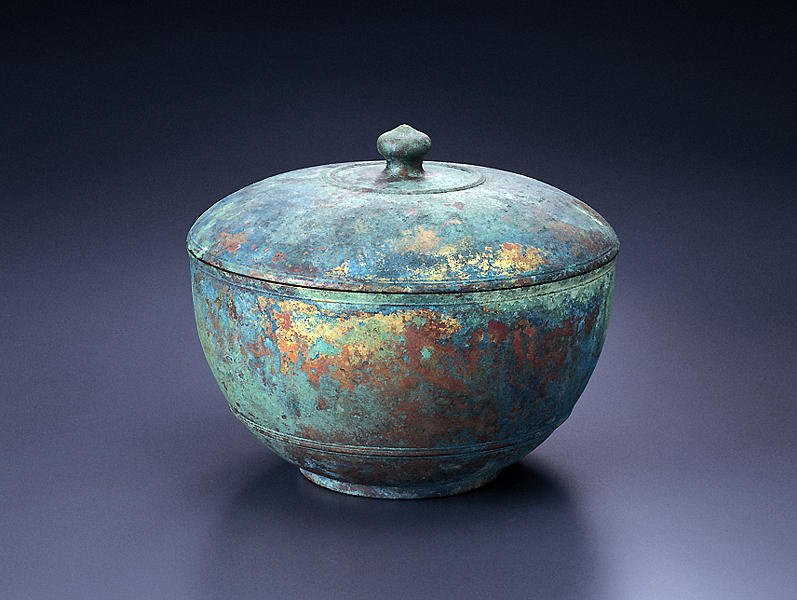金銅合子
- 滋賀県甲賀郡出土
- 鎌倉時代
- 13c
- 金銅製
- H-20 D-25
- 所蔵
- 滋賀県甲賀郡出土
鎌倉時代 13世紀
高:20.0cm 口径:25.0cm
銅鋳製の合子で,全面に青錆が覆っているが,その下には鍍金(金メッキ)が認められる。蓋は,ゆったりとした甲盛りがあり,頂に大型の宝珠形鈕をつけ,その外側に突帯をめぐらし,外周近くにも突線を表す。身は,口縁に向かっておだやかに開く鋺形で,最下に低い高台をつけ,そのやや上方に突帯を,口縁近くにも突線を表している。蓋と身は,蓋裏の外周近くに蓋がかりを鋳出して,身と合口となるように作られている。蓋身とも鋳造ののち,轆轤で挽いて整形しているが,大型でしかも厚手の鋳造であるため重量がある。
このような形式の鋺は,古来,飲食供養のための鋺にしばしば見られるが,本品が出土品であることを勘案すると,墓塔などに納置する蔵骨器であった可能性も想定されよう。
蓋の頂の低平で大きな鈕や,蓋身にめぐらされた,いわゆる子持ち突帯の形式から,鎌倉時代後半期の製作と考えられる。
なお,出土地については,滋賀県甲賀郡とされているが,詳細についてはわからない。(関根)
Catalogue Entry
Kamakura period, 13th century
Gilt bronze
Height, 20.0cm; mouth diameter, 25.0cm
This cast bronze bowl is covered completely with rust, and plate gold gilding can be confirmed beneath that rust. The lid has a gently rising curved shape with a large jewel-shaped knob attached to the top of the lid. The outer edge of the area around the knob is banded by a raised border, and the outer edge of the entire lid also has a raised band. The body is a gently swelling form that expands toward its mouth, with a low foot attached at its base, a protruding band near the top of this foot, and another protruding band near the mouth edge. The lid seats well into the mouth of the body, thanks to an inner-lid lip cast near the edge of the interior of the lid. After casting, the form of the body of the lid was finished on a wheel, and its large, thickly cast shape means that the overall form is quite heavy.
This shape of bowl was frequently used for food and drink offerings, and given that it is thought that this bowl was excavated, there is also the possibility that this covered bowl was placed in a tomb as an ossuary.
The low, rounded knob on the top of the lid and the form of the raised bands around both body and lid indicate a date of production in the latter half of the Kamakura period.
This bowl is said to have been excavated in Koga-gun, Shiga prefecture, but detailed information is not available. SS
